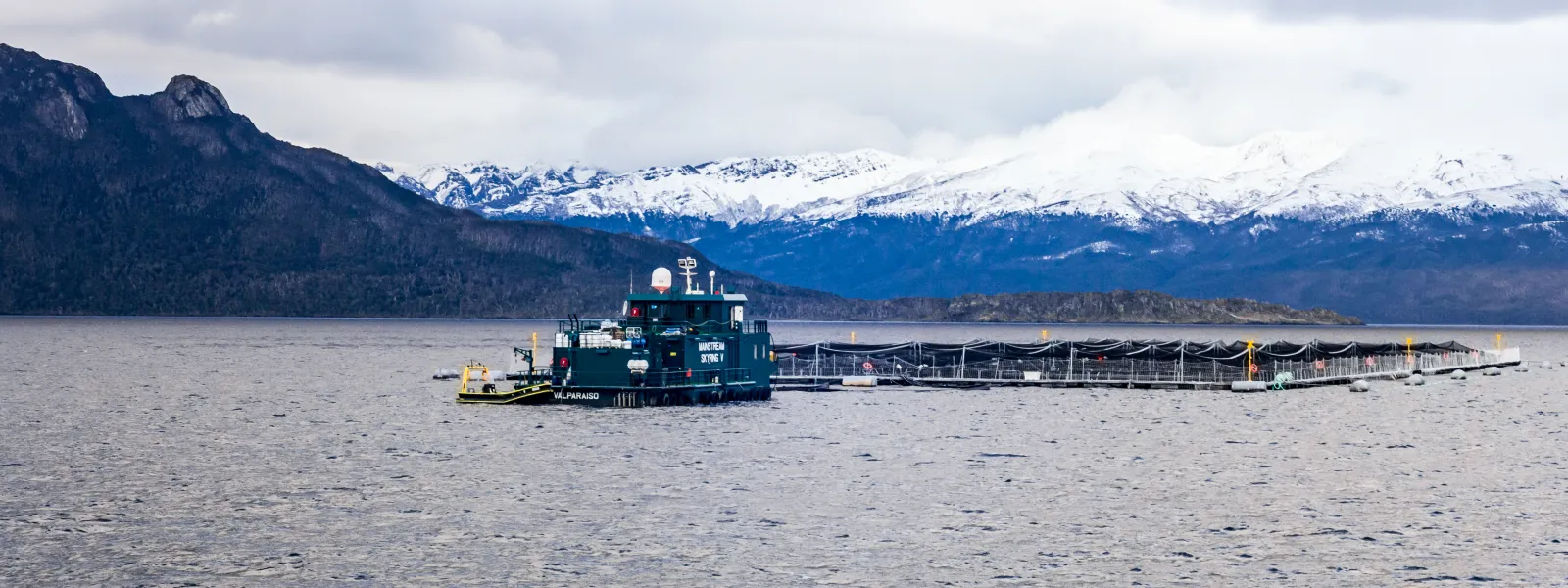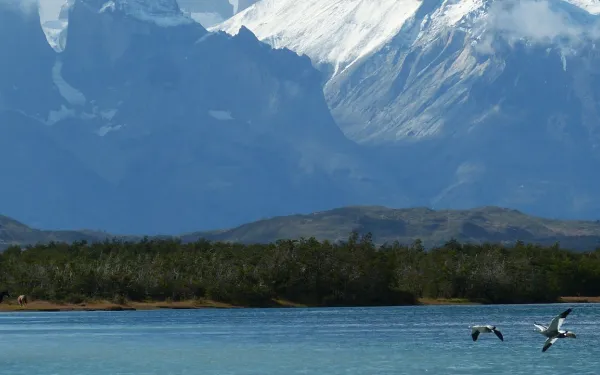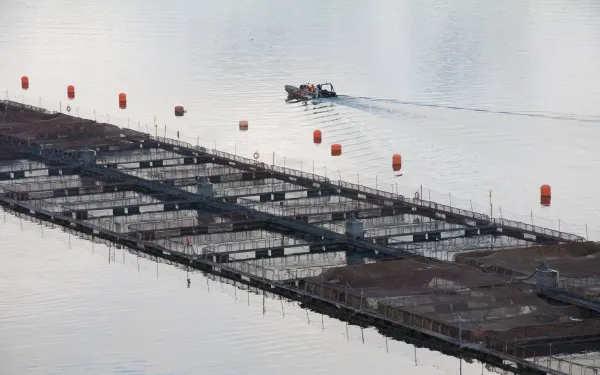
Project
Photo: #RealChileProtecting Patagonian Seas from Salmon Farms
The Straight of Magellan in Chilean Patagonia (or Magallanes, as it’s known in Spanish) hosts the largest number of natural protected areas in the country. Permanent snow feeds the idyllic landscape, which has been shaped by glaciers, lakes, rivers and seas. Within its bounds live protected species—blue whales, sperm whales, Magellanic penguins, elephant seals, leatherback turtles, and southern and Chilean dolphins.
The cold waters of this far corner of the world are pristine; this makes them more sensitive to high-impact human activities. And now they’re being stressed by the arrival of salmon farms, which have already caused severe environmental damage in regions further north.
In Chile, the salmon industry uses harmful techniques and operates without proper regulation. Its rapid growth has overwhelmed coastal waters, filling them with huge amounts of antibiotics, chemicals, and salmon feces. These pollutants have led to partial or, in some places, complete lack of oxygen in the water, threating all forms of marine life.
Large salmon farms in the Magallanes region are already causing big damage. According to a government audit, more than half of the salmon farms operating there are affecting the availability of oxygen in the water, a condition that did not occur prior to their arrival.
Partners:

Related projects
Latest News

Chilean chum: How eating salmon in the US hurts Patagonia’s coastal wildlife
After two years of vegetarianism, the Texan in me decided that an entirely plant-based diet was not going to work. The experience, however, taught me to consume meat ethically. Wherever possible, I now choose organic and sustainable “farm to table” meat and poultry. But when it comes to my favorite seafood—salmon— “farm to table” can take on a whole new meaning. Salmon is one of the most popular seafoods in the United States, and over a third of all salmon in the U.S. comes from Chilean salmon farms, which raise the carnivorous fish in off-shore enclosures along the Patagonian coast. Although salmon is healthy—it’s loaded with omega-3 fatty acids and B-vitamins—increased U.S. demand for salmon is having an unhealthy impact on Chile’s environment. These farms endanger delicate coastal ecosystems, contribute to oceanic pollution, and threaten marine life along the pristine Magallanes shoreline. Chile is the second largest global exporter of the fish, and salmon farming is one of the country’s largest industries. Today, that industry is growing. There are already over 100 salmon farms operating in the Magallanes and, as of March 2017, plans for 342 more were in the works. Driving this expansion is a booming worldwide salmon market. But even though the U.S. boasts a salmon industry of its own and wild-caught Alaskan salmon is considered some of the best in the world, U.S. consumers ate over 144,000 tons of farmed Chilean salmon in 2016, according to the National Oceanic and Atmospheric Administration. A fishy situation While fish farms are one solution to the many problems associated with overfishing, Chile’s unregulated salmon industry has serious environmental side-effects. These salmon farms disrupt their environments because overpopulated waterways create anaerobic conditions that deprive the local wildlife of oxygen. Often treated with excessive amounts antibiotics and pesticides, uneaten salmon feed and salmon feces also pollute coastal seafloors and introduce chemicals into the environment. Because they are not native to the southern hemisphere, salmon that escape their pens can disrupt local food chains. Salmon also frequently die in their enclosures, and the decomposing fish raise levels of ammonia in the water. Although research is still underway, scientists speculate that higher concentrations of ammonia, along with El Niño weather patterns and warming oceans caused by climate change, may be responsible for Chile’s recent “red tides.” These toxic red algae blooms kill coastal wildlife by the millions, inundating Chilean shores with dead fish (including salmon), birds, and whales. To fight back against this destructive industry and the harmful impacts of globalized seafood trade, AIDA filed a claim with the Chilean government expressing concern that salmon farms are harming local ecosystems. “We want to improve the way things are being done by aiming for sustainable development that will not ruin the fragile ecological balance of the Patagonian seas,” AIDA attorney Florencia Ortúzar said. AIDA also recently began a petition asking that Chile investigate the damage caused by salmon farming in the Magallanes and sanction those responsible. You can sign the petition here. New migration routes Today, the U.S. salmon industry practices catch and release: it is known for producing high quality fish, yet 80 percent of Alaskan wild salmon is traded away. So why does the U.S. produce some of the world’s best salmon, but consume some of the world’s most environmentally harmful fish? The answer, in short, is globalization. Filleting and de-boning salmon is a process too delicate to mechanize as in other meat industries. Because labor is cheaper in Asia, U.S. salmon is shipped to processing plants in China, which then re-distribute the processed fish across the region. While some of that salmon makes it back across the Pacific, the U.S. market is flooded with cheaper farmed salmon from around the world. Now, Chile’s industry “is facing competition from Canada and Norway,” according to trade analysis group Datamyne. After expressing concerns over high levels of antibiotics in Chilean fish, U.S. retail giant Costco decided in 2015 to stock Norwegian salmon instead, further muddying the waters in the U.S. salmon trade. To make matters worse, a study by conservation nonprofit Oceana concluded that nearly 43% of “wild” salmon sold in the United States was misidentified. While it is difficult to tell whether farmed salmon is mislabeled as “wild” during trade or once it shows up on the menu, lax labeling laws in the U.S. make it difficult to tell exactly where that salmon steak came from. So for seafood lovers like me, there may be few good options for eating salmon sustainably, besides taking up fly fishing. But for the sake of protecting Chile’s coastal wildlife, maybe it’s time U.S. consumers make their voice heard. If we’re going to import salmon from Chile, we should at least demand the country regulate its farms to be more environmentally friendly. Maybe it’s also time the U.S. salmon industry started keeping its catch in its own boat. Sign the petition to protect Patagonia’s Magallanes coastline here.
Read more
Calling on Chile to protect Patagonia from the risks of the salmon industry
More than half of the salmon farms in Chile’s Magallanes Region are depleting oxygen from sensitive marine waters, suffocating marine life. Civil society organizations filed an administrative complaint and a petition calling on the government to investigate and punish farm operators, and to enforce existing regulations. Santiago, Chile. Civil society organizations filed a complaint today asking the Superintendent of the Environment to investigate damages caused by salmon farms in the Magallanes Region of Southern Patagonia, and to sanction the companies responsible. According to government reports, salmon farms in the area are depleting the water of oxygen, causing a serious threat to marine life. The organizations also launched a citizen’s petition to support the formal complaint. “Salmon farming concessions have been approved in Magallanes without a detailed assessment of the impacts the industry may have on the region,” said Florencia Ortúzar, an attorney with the Interamerican Association for Environmental Defense. “The damages are already occurring: a report by the Comptroller General of the Republic found that, between 2013 and 2015, more than half of the salmon farms in Magallanes created anaerobic conditions, gravely threatening marine life.” Chile is the world’s second largest producer of salmon. The industry, which developed on coasts further north, has now entered the Magallanes region in the southermost tip of the country. The pristine waters there are highly vulnerable to human activity. Magallanes has the largest number of protected natural areas in the country; it shelters such protected species as the blue whale, the sperm whale, the Magellanic penguin, the elephant seal, the leatherback sea turtle, the southern dolphin, and the Chilean dolphin. “Salmon farms are cultivating more fish than the ecosystem can withstand. They are filling sensitive waters with chemicals and antibiotics,” said Francisco Campos-Lopez, director of #RealChile. “Those chemicals, combined with the feces of the animals, cause a dangerous lack of oxygen in the waters, endangering sea life.” NOTE: More information available at aida-americas.org/salmonfarms Press contacts: Florencia Ortúzar, AIDA Attorney, +56 9 7335 3135, [email protected]
Read more
Chile’s Salmon Farms: Sustainability is Impossible
By Florencia Ortúzar Chile is the second largest producer of salmon in the world. For more than 20 years, the industry has put profit above environmental protection. In the absence of government regulation, large-scale salmon farms release contaminating chemicals and create oceanic dead zones. They hurt other species and harm the people and communities that depend on the ocean for sustenance. The situation is bad, but it could get worse as the industry looks to expand into new areas of pristine waters. Bad Practices Salmon farming in Chile will never be sustainable because it requires much more protein to operate than it generates. Salmon are carnivorous. To produce one kilo of salmon you need about five kilos of wild fish for feed. Years of bad business practices and lack of government regulation have resulted in serious environmental damage, which has, in turn, brought grave social consequences to those who depend on seafood for their livelihoods. On the Big Island of Chiloé, for example, seaweed and shellfish gatherers, artisanal fishermen and people who work in plants that process wild-caught fish are experiencing massive unemployment. This social crisis is a direct result of the environmental catastrophe caused in large part by the salmon industry, which has extensive operations in the area. In Chile, developers must present declarations or environmental impact studies that examine their project’s potential to harm nature. Despite the great risk to ecosystems, salmon farms are supported by mere affidavits, and not by studies that would allow for the identification and proper handling of potential negative impacts. The result is thousands of salmon hatcheries. Each one consists of floating cages that, without sufficient spacing or adequate sanitation, house thousands of salmon crammed into small spaces (half the space allowed in Europe). Although it seems difficult to believe, and despite the law saying otherwise, in Chile no studies have been done on the ability of the ocean, lakes, and rivers to accommodate the number of salmon that are grown. These captive salmon are fed pellets that contain a mix of wild fishmeal, pesticides, dyes, fungicides, and chemicals used to speed growth. A majority of these pellets are not consumed and simply fall to the seabed. Additionally, each salmon is injected with an exorbitant quantity of antibiotics (up to 5,000 times more than used in Norway). Finally, the waste generated by the fish, which contains chemicals, also accumulates on the ocean floor. More than 20 years of these practices have caused dead zones in the ocean where life is no longer possible. Another serious problem with the industry is that salmon often escape from their cages. According to a report by the NGO Terram, escaped salmon in Chile represent 1.5 percent of the total production, equivalent to more than 9,000 tons per year. Some studies report that this percentage could reach as high as five percent. Although by law farms must have recapture plans, they rarely succeed. Salmon are an aggressive fish. When free, they compete with native fish for food and shelter, and transmit disease. Crisis in the Sea In May, Chile’s coasts were devastated by an unprecedented red tide, believed to be the country’s worst recent environmental crisis. The natural phenomenon, characterized by an excessive increase in microalgae, resulted in the beaching of whales, squid, sardines and even birds. Captive salmon were also affected and the industry suffered huge losses: thousands of tons of salmon carcasses rotted in floating cages. The death rate was such that the national maritime authority authorized the release of 9,000 tons of dead salmon into the sea. According to the salmon industry and the government, the red tide was caused by El Niño, which was aggravated by global warming. However, some scientists have said that the salmon industry is largely to blame for submitting the ocean to their bad practices for so many years. Patagonia Without Salmon Farming! Not only has the salmon industry not learned from its mistakes, but it is also looking to expand into new, uncontaminated waters. It’s happening in the Patagonia regions of Magallanes and Aysen, where approximately 3,100 applications for salmon farms are awaiting approval. Farms were even proposed for places declared as priority conservation sites. Together with our allies, AIDA is working to ensure salmon farming and other industries comply with environmental standards. But there’s something you can do too, as citizens and consumers. Vote with your pocketbook. By purchasing only sustainable seafood products, you can help prevent the creation of more dead zones in our oceans.
Read more